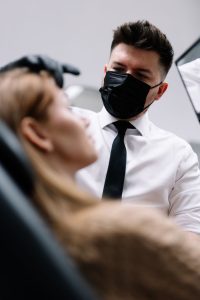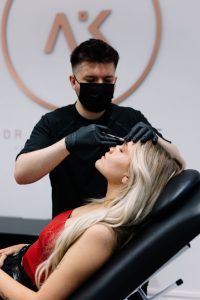Are Botox and fillers safe?
Although no medical procedure is 100% safe, when carried out by an experienced medical practitioner, the risks of Botox and fillers are low.
Patient safety is critical to me, so I’ve focused on gaining the best education and experience to carry out facial aesthetics. I use the most advanced modern injection techniques, developed by the world’s leading injectors, to optimise aesthetics and maximise the procedure’s safety. I also provide a follow-up appointment as well as a 24-hour emergency access number, if needed.
Does it hurt?
The comfort levels of each treatment vary depending on what treatment you choose and where in the face is being treated. Some areas can be a little bit more uncomfortable than others. But we’ve developed several ways to reduce the pain and discomfort of treatments.
For specific treatments like wrinkle reduction, I use premium needles that are extremely thin compared to other needles. This reduces pain, bleeding and bruising risk, so that the treatment is very comfortable. For many treatments, I use numbing cream and the filler used has a numbing agent inside, which helps reduce the sensation to the skin to make it more comfortable.
How long do Botox and fillers last?
Botox treatments last around three months, at which full movement will return. Whereas filler treatments last longer – about 12-18 months, depending on the area treated.

What is the difference between Botox and fillers?
Botox is a drug that is injected into the muscle reducing muscle activity. It is great at erasing or softening lines and wrinkles, particularly frown lines and the crows feet beside the eyes. However contrary to popular belief botox does not alter the face shape or affect skin quality.
Filler on the other hand is made up of hyaluronic acid, a clear gel which is found naturally within our body. It is injected into different layers altering facial structure. It can be used strategically to boost volume in certain deflated areas. As we age we start to lose volume in a variety of areas across our face such as the temples, cheek and underneath the eye. Skilfully placed filler can easily revolumise these areas allowing us to achieve a subtle natural result – meaning you still look like yourself, just fresher.
What should we look for when choosing a clinic?
Choose an experienced medical practitioner who hasn’t only attended a one-day course. Sadly, there are a lot of practitioners operating out of their depth. You can ask practitioners for their qualifications and experience; they should be happy to tell you. You could also ask for a portfolio of their treatments to ensure that they’re happy and comfortable providing the type of treatment you’d like. If your practitioner rushes your consultation, this is likely to be a major red flag.
What questions do we need to ask during a consultation?
Discuss your concerns and be specific about what areas are causing you concern. It’s essential that you feel like your practitioner understands precisely what your problem is and lists the full treatment options available to you. It’s also helpful to mention if you’ve had any previous treatments and whether you were happy with them or not.

How do you personalise treatments to each individual?
Here at the clinic, I offer a free 60 minute consultation as it’s such an important part of the treatment process. Where, we discuss concerns, ideas and expected outcomes of the treatment. I assess the whole face in layers, including the skin, the muscle, fat and the bone. This allows me to create an exact diagnosis of the issue and potential solutions for you.
What are the possible side effects?
As with any medical procedure, there are always risks. But, overall, the risks are rare and, if treated by an experienced medically qualified practitioner, then any complications are reduced. The small risks of Botox include a heavy brow, droopy eyelids or asymmetric results (which are temporary). Complications arsing as a result of filler can be more severe including bruising, temporary swelling/lumpiness and in the worst instances if a problem is not appropriately managed then can lead to necrosis and visual disturbances. Filler can however be easily dissolved and if treated early by a qualified practitioner is unlikely to cause any permanent damage.
What’s the most popular treatment at your clinic?
A lot of patients come to me saying they look or feel ‘tired’ or ‘aged’ and are open to suggestions of what might make them look fresher. A popular first treatment is relaxing the frown muscles between the eyes, as well as filler placed in the midface (under the eye and cheek area). Placing filler in this area can help us rejuvenate the appearance of the under-eye, subtly recontour the cheek and achieve a natural lift to help sagginess in the lower face.
Profhilo is another very popular treatment of ours sepecially in the winter as our skin gets dried out by the cold. This is a less invasive alternative to filler and works like an injectable moisturiser or skin booster which stimulates the collagen in the skin giving a fresh glowing appearance without altering the shape or volume of the face

Aesthetics treatments have a stereotype of looking fake. How are you working towards creating more of a ‘natural’ look?
A detailed knowledge of natural anatomy, as well as how the ageing process occurs, is key. I thoroughly assess your face and create a plan bespoke to you. I look to improve the lines and wrinkles and then replace volume that has been lost through the ageing process. If done skilfully, this always achieves excellent, natural results.

